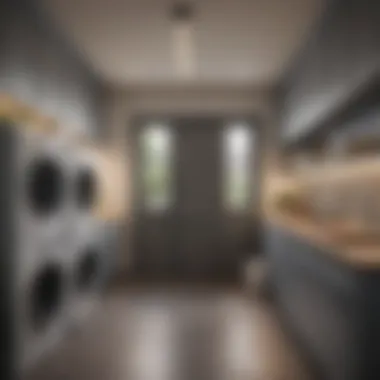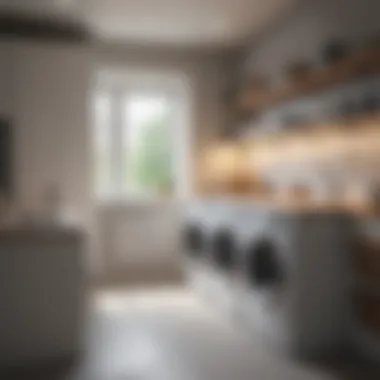Finishing Your Laundry Room: A Complete Guide


Intro
Designing a laundry room involves more than just equipment placement. It is a blend of function and style, often overlooked in the home improvement process. This article will help you navigate the essential components to create a laundry room that is not only practical but also a reflection of your personal taste. From layout considerations to storage solutions, each element plays a significant role in the overall efficiency of the space.
Key Insights and Trends
Current Trends in Interior Design
In recent years, there has been a shift towards multifunctional spaces in the home. Laundry rooms are progressively designed to accommodate additional functions, such as crafting or task management areas. Open shelving is becoming popular, as it offers visibility and easy access to tools, detergents, and other supplies.
Muted color palettes combined with bright accents are dominating laundry room designs, creating a calm yet dynamic atmosphere. The use of natural materials and textures is also on the rise, enhancing warmth and inviting aesthetics in the often utilitarian space.
"The laundry room doesn't have to be just a place for chores; it can be a stylish and functional area that enhances your home."
Popular Storage Solutions
Efficient storage is key to maintaining order in a laundry room. Popular choices include:
- Wall-mounted cabinets: Optimizes vertical space.
- Rolling carts: Offers flexibility and can be relocated as needed.
- Stackable bins: Provides compartmentalized storage, keeping items organized.
Practical Tips and How-To Guides
Step-by-Step Guides for Laundry Room Design
- Assess Your Space: Measure your room dimensions to determine layout.
- Select Your Appliances: Choose energy-efficient models that fit your needs and style.
- Choose a Layout: Consider L-shape, U-shape, or galley layout based on space availability.
- Plan Storage Solutions: Incorporate cabinets, shelves, and hampers that reflect your organizational style.
- Consider Lighting: Good lighting improves functionality; think of overhead lights and task lighting.
Aesthetic Considerations
- Use paint or wallpaper to personalize the space.
- Integrate decorative items such as art or plants to elevate the room's visual impact.
- Flooring choices can influence the feel of the space; durable materials recommended.
Engaging with these elements ensures a laundry room that is not only efficient but also tailored to your lifestyle preferences. By applying these insights and strategies, any homeowner can achieve a well-designed laundry area.
Understanding the Importance of a Laundry Room
A laundry room is more than just a space to wash clothes. It serves a crucial role in home management, efficiency, and overall quality of life. This article dives into the various aspects that highlight its significance. Homeowners often overlook this space, but a well-designed laundry room can enhance functionality, promote organization, and elevate the home’s aesthetic appeal.
Functionality vs. Aesthetics
When designing a laundry room, it is essential to balance functionality with aesthetics. On one hand, functionality ensures the area is practical for daily tasks; on the other, aesthetics provide a pleasant environment. The layout must accommodate washing machines, dryers, and storage, making it easy to move between tasks.
Efficient storage solutions, such as shelves and cabinetry, can be used to create an organized workspace. Sorting materials into designated categories keeps everything within reach and reduces clutter. However, the choice of colors and finishes also plays a role in creating an inviting space. Light colors can make the room feel larger, while darker tones can lend depth and interest. A well-designed laundry room should facilitate both productivity and comfort.
Impact on Home Value
A laundry room does not merely serve its immediate purpose; it also affects the overall value of the home. Potential buyers often view a well-equipped laundry space as a desirable feature. It represents practicality, and having one can be a significant selling point. In determining home value, factors such as layout, availability of appliances, and aesthetic appeal contribute to the overall impression.
"Investing in a functional and stylish laundry room can yield substantial returns when selling your home."
A thoughtfully designed laundry room can create a positive impact on potential buyers’ perceptions. When they visit a home, seeing an organized, efficient laundry space can enhance their overall experience, making the home more attractive.
In summary, understanding the importance of a laundry room involves recognizing its dual role in functionality and aesthetics. It is an investment that can significantly influence home value worthy of careful consideration as homeowners aim to create not just a practical space, but a desirable one.
Determining Your Laundry Room Layout
The layout of your laundry room is crucial for both efficiency and comfort. A well-planned layout contributes significantly to the overall functionality of the space. When you determine the layout, you consider how to optimize the area you have. The ideal laundry room layout can make chores feel less tedious and create a better work environment.
Factors like the size and shape of your available space dictate how you can arrange appliances and storage. Each unique layout option comes with its advantages. Understanding this helps homeowners select the best approach for their needs, paving the way for an organized and efficient laundry experience.
Evaluating Available Space
Before settling on a layout, evaluating your available space is essential. Measure the dimensions of your laundry area, noting the positions of outlets, plumbing, and doors. This assessment helps identify limitations, such as clearances required around appliances. Also, consider any cabinets or shelving currently in place. Taking stock of these factors gives a sense of the possibilities.
Once you have a complete picture, you can create a drawing or layout plan. This can be a simple sketch that includes the dimensions, or even a digital layout. Although it may seem tedious, this groundwork pays off when deciding how to arrange your appliances and storage.


Popular Layout Options
There are several popular layout options for laundry rooms, each serving different needs. Understanding these options allows you to choose wisely based on your specific requirements. Here are three notable configurations:
Side-by-Side Configuration
The side-by-side configuration has two appliances placed next to each other. This design is often favored for its ease of use. It allows for quick transfers between the washer and dryer, which is a key characteristic. The advantage is that you can unload clothes directly from the washing machine into the dryer without walking across the room.
However, this layout requires a wider space, making it less suitable for smaller areas. If you have room, opt for this configuration as it improves efficiency significantly.
Stacked Appliances
Stacked appliances save space by placing the dryer on top of the washer. This option is particularly beneficial for smaller laundry rooms. Key characteristic includes greater efficiency in space utilization. The unique feature is that it minimizes the footprint in the room, leaving more area for storage or even a small folding station.
On the downside, reaching the top appliance can be awkward for some users. Consider your own needs before choosing this layout. It can be a space savior, but accessibility must be factored in.
Dedicated Laundry Rooms
Having a dedicated laundry room means that the space is specifically used for laundry tasks alone. This option allows for a well-thought-out design that can include various appliances, storage, and even a folding area. A key characteristic is flexibility. In a dedicated space, you can customize every detail, from cabinetry to lighting.
The unique feature of a dedicated laundry room is that it can enhance your home’s overall functionality. However, the main challenge is that it often requires a larger budget or more available square footage. If possible, this arrangement offers the best balance of utility and convenience.
A thoughtful layout can greatly enhance the efficiency of your laundry room, making chores easier and more organized.
By exploring these layout options, you can determine which best meets your needs and available space.
Selecting Appliances for Your Laundry Room
Selecting the right appliances for your laundry room is crucial for optimizing both functionality and efficiency. It is not merely about having a washer and dryer. The decision impacts your daily routines, energy consumption, and even the aesthetic of your space. In this section, we will explore several important considerations that should guide your choices when outfitting this essential area of your home.
Energy Efficiency Considerations
When choosing appliances, energy efficiency should be high on your priority list. Many appliances now come with energy labels that indicate how much energy and water they consume. High-efficiency washers, for instance, use significantly less water compared to standard models. They also incorporate advanced technology that reduces the amount of energy needed for heating water.
Here are some key benefits of selecting energy-efficient appliances for your laundry room:
- Cost Savings: Though the initial investment is sometimes higher, the savings on utility bills can be substantial over time.
- Environmental Impact: Reduced energy and water usage decrease your overall carbon footprint, contributing to environmental sustainability.
- Better Performance: Many energy-efficient washers and dryers use modern technology to clean clothes more effectively.
Consideration: Look for appliances that are certified by programs such as ENERGY STAR. This certification ensures they meet strict efficiency guidelines set by the U.S. Environmental Protection Agency.
Smart Technology in Laundry
The integration of smart technology into laundry appliances is revolutionizing how we do laundry. Smart washers and dryers offer features that go beyond traditional machine functions, enhancing convenience and optimizing laundry tasks.
Some potential features include:
- Remote Monitoring: You can check the status of a laundry load from anywhere using a smartphone app, which is particularly useful for busy schedules.
- Notifications: Smart appliances can send alerts when cycles are finished or if maintenance is required.
- Custom Wash Settings: Many smart machines offer customizable cycles that are tailored to specific fabrics or soil levels.
Incorporating these smart appliances into your laundry room not only adds convenience but also minimizes unnecessary wear and tear on clothing, potentially extending their life span.
"The future of laundry is here, and it’s smarter than ever. Embrace technology for efficiency."
Overall, when selecting appliances, prioritize those that will serve your needs while enhancing efficiency. Take the time to research and compare models, keeping your specific requirements in mind. This effort can streamline your laundry process and elevate your laundry room into a truly functional space.
Storage Solutions for a Functional Laundry Room
Storage solutions hold great significance in designing a laundry room. Adequate storage keeps the room organized and efficient, reducing clutter and streamlining laundry tasks. When laundry spaces lack proper storage, they can become chaotic and frustrating. Selecting suitable storage options not only enhances functionality but also contributes to a more visually appealing environment. Discovering various storage methods allows homeowners to customize their laundry area according to their individual needs.
Maximizing Vertical Space
Vertical space often goes underutilized in laundry rooms. Adding shelves that extend upward creates extra storage without occupying more floor space. Options like wall-mounted shelving are practical and can hold baskets, detergents, and other laundry supplies. These shelves can be adjustable to accommodate different items. Hooks or pegboards on the walls can also help hang frequently used items, making them readily accessible without requiring drawer or counter space. Another clever way to utilize vertical space is by installing cabinets that reach the ceiling; this eliminates dust accumulation on top and provides additional storage for less-used items.
Cabinetry Options


Cabinets are essential for maintaining a tidy and functional laundry room. Choosing the right cabinetry adds style and allows for effective organization. Options vary from open shelves that showcase decor to closed cabinets that hide necessities. Many homeowners prefer cabinetry that matches the overall aesthetic of the home. Consider modular or custom cabinets if the space allows; these can be tailored to fit specific needs. Moreover, cabinet organizers such as pull-out bins and lazy Susans can help maximize every inch of storage. This way, items remain easy to find, promptly enhancing efficiency during laundry day.
Creative Organizing Techniques
Inventive organizing techniques can transform a cluttered laundry room into a functional space. Using containers with labels promotes order. Clear bins can help identify contents quickly, while labeled baskets can differentiate between linens, delicates, and regular items. Incorporating a rolling cart is practical for moving supplies easily. This can be especially beneficial for larger families.
Moreover, consider using small drawer units for smaller items like dryer sheets or laundry pods. Over-the-door organizers can also work wonders for holding items such as fabric softener or cleaning supplies, effectively keeping harmful substances out of reach from children or pets.
"An organized space allows for a streamlined process, ensuring you maximize the functionality of your laundry room while maintaining a clean and appealing atmosphere."
In summary, focusing on effective storage solutions transforms the laundry room into a space that supports daily routines, enhances usability, and showcases personal style.
Lighting Considerations in the Laundry Room
Effective lighting in the laundry room is not merely an afterthought; it plays a fundamental role in the overall functionality and aesthetic appeal of the space. A well-lit laundry area enhances visibility, ensures safety while operating appliances, and can even make the room feel more inviting. It's essential for homeowners to consider both the type of lighting and its placement to achieve optimal results. Proper lighting can elevate the laundry experience, making tasks easier and more enjoyable—a valuable benefit for spaces that often require considerable effort.
Types of Lighting
Ambient Lighting
Ambient lighting serves as the primary light source in a room. Its objective is to provide uniform illumination without creating harsh shadows. Typically created using ceiling fixtures or wall sconces, ambient lighting sets the overall tone of the laundry space.
One key characteristic of ambient lighting is its ability to create a soft, warm atmosphere. This makes it a beneficial choice for homeowners who seek to transform their laundry area into a more welcoming space.
The unique feature of ambient lighting is its versatility; it can be dimmed or adjusted depending on the task or personal preference. However, while ambient lighting provides general illumination, it may lack the concentrating power needed for detailed tasks, which is where additional lighting can be advantageous.
Task Lighting
Task lighting focuses on illuminating specific areas where detailed work is done. This lighting type is crucial for laundry rooms, where sorting, folding, and ironing may take place. A distinctive aspect of task lighting is its directed illumination, which highlights work surfaces more effectively than ambient light. It’s a popular choice in laundry settings due to its ability to reduce the chance of errors and increase efficiency in completing chores. For instance, LED under-cabinet lights or pendant fixtures above folding stations can substantially enhance visibility. However, one downside is that task lighting can sometimes create glare if not positioned correctly, necessitating extra attention during the design phase.
Natural Light Utilization
Maximizing natural light in the laundry room is an often overlooked but effective strategy. Natural light not only energizes the space but also benefits the environment through reduced reliance on artificial lighting. This can lead to lower energy costs over time. Incorporating large windows, skylights, or strategically placed mirrors enhances light flow, creating a brighter and more vibrant atmosphere. Careful consideration should be given to window treatments, as they should allow light in while still providing privacy
In summary, focusing on appropriate lighting solutions in the laundry room enhances its functionality significantly. Combining ambient, task, and natural light thoughtfully can create a space that is efficient, welcoming, and enjoyable to use.
Flooring and Wall Options
In any laundry room, flooring and wall treatments play a critical role in both functionality and aesthetics. While most might overlook these aspects, the choices made here impact everyday tasks and the overall ambiance of the space. Selecting appropriate materials can enhance durability, ease of cleaning, and comfort while also reinforcing personal style.
Choosing Durable Flooring
When it comes to flooring, the laundry room demands material that withstands moisture and staining. Ceramic tiles, vinyl, and laminate are popular options, each offering unique benefits.
- Ceramic Tiles: These are known for their water resistance and durability. They can be easily cleaned using standard cleaning solutions. Another advantage is the variety of designs available, allowing for creative expression.
- Vinyl Flooring: This is often a cost-effective choice with water-resistant properties. Modern vinyl comes in various patterns and textures, even mimicking wood or stone.
- Laminate Flooring: It is less common but durable. While it offers affordability, care is needed to prevent moisture from seeping in.
Consider the installation and maintenance of these materials. Certain types may require professional help, leading to added costs. Also, choose slip-resistant options when designing your layout. Safety is crucial, especially in areas prone to spills.
Wall Treatments for Functionality and Style
The walls of a laundry room should not only serve a protective function but also enhance the space's aesthetic. Paint, tiles, and wall panels each offer unique benefits.
- Paint: A simple coat of paint can do wonders. Opt for washable, moisture-resistant paint to prevent mildew and facilitate easy cleaning. Lighter colors can make a small room appear larger and more welcoming.
- Tiles: For a more sophisticated look, consider using tiles halfway up the wall. This protects against splashes and adds visual interest. Many ceramic options are both stylish and functional.
- Wall Panels: These can provide additional insulation and protection. They also offer a certain texture that can make the room feel cozier. This can be particularly effective in modern designs.
Important Note: When selecting wall treatments, always consider longevity and your cleaning preferences. Choose options that are not just beautiful but are also easy to maintain.
Each decision regarding flooring and wall options contributes to the laundry room's functionality and style. Prioritize durability and ease of maintenance to create an efficient and pleasant space.
Incorporating Technology in Your Laundry Room
In today's fast-paced world, technology has become integral to our daily lives. This extends to the laundry room, a space often relegated to functionality over style. Incorporating technology not only enhances the efficiency of laundry tasks but also brings an element of convenience that can significantly improve the user experience. As homeowners seek to modernize their homes, optimizing the laundry room with the right technology can fulfill multiple needs and preferences.
Smart Appliances Overview
Smart appliances represent a significant advancement in laundry room technology. These devices are designed to ease your chores and add functionality. For example, modern washing machines, like the LG WM9000HVA, come with app integration that allows you to start or stop cycles remotely. This connectivity offers flexibility, crucial for busy homeowners.
Benefits of Smart Appliances:
- Remote Control: Start, pause or set a wash cycle from your smartphone.
- Cycle Optimization: These machines often adjust water usage based on the load size, offering eco-friendly options.
- Notifications: Receive alerts when washing or drying is complete. This feature can save you from waiting around for laundry to finish.


Home Automation Integration
Integrating your laundry room with home automation systems can enhance practicality and simplify your laundry routine. Systems like Google Home or Amazon Alexa can allow voice commands for various tasks. By incorporating sensors, your laundry room can also automatically send alerts for maintenance needs, such as when a filter requires cleaning.
Benefits of Home Automation:
- Hands-Free Control: Use voice commands to manage laundry tasks.
- Monitoring: Keep track of your energy consumption through connected devices.
- Safety Features: Smart systems can alert you to leaks or potential malfunctions.
In summary, the integration of technology into your laundry room offers significant advantages in efficiency, convenience, and modern living. As more homeowners recognize the importance of a functional yet stylish laundry space, investing in smart appliances and automation systems becomes a wise choice.
Sustainability Practices for Your Laundry Room
Integrating sustainability into your laundry room design is essential for both environmental and financial reasons. As this space is frequently used for household chores, adopting green practices enhances efficiency while lowering utility costs. Focusing on sustainability helps in reducing carbon footprints and promotes a healthier living environment.
Water and Energy Efficiency
When it comes to sustainability, water and energy efficiency are fundamental aspects.
- Select Energy Star Appliances: Investing in Energy Star-certified washers and dryers can significantly reduce energy consumption. These appliances often use less water and energy compared to their conventional counterparts.
- Use Cold Water Settings: Washing clothes in cold water saves energy usually used for heating water. Furthermore, it is gentler on fabrics, resulting in longer-lasting clothing.
- Install Low-Flow Fixtures: Consider low-flow faucets and hoses that minimize water usage without sacrificing performance. These fixtures efficiently manage water consumption, aligning with sustainability goals.
- Optimize Load Sizes: Always wash full loads instead of small ones. This practice maximizes the efficiency of both water and energy use during each washing cycle.
By understanding these elements, you can create a laundry room that values resources and minimizes waste.
Eco-Friendly Products and Practices
Using eco-friendly products in your laundry room goes beyond choosing the right appliances. It extends to the soaps, cleaning agents, and general practices employed in the space.
- Biodegradable Detergents: Opt for laundry detergents that are free from phosphates and chlorine bleach. These products are less harmful to the environment and often just as effective, ensuring that your clothes are both clean and eco-conscious.
- Vinegar and Baking Soda: Utilize substances like vinegar and baking soda for natural cleaning. They are safe for the environment and help eliminate odors without the need for harsh chemicals.
- Hang Dry Clothes: Whenever possible, air dry clothes to save energy. This simple practice reduces reliance on electric dryers and can prolong the life of your garments.
- Consider Secondhand Items: If you need to furnish your laundry room, look for secondhand storage solutions or repurpose existing furniture. This practice not only saves you money but also reduces the demand for new products.
Incorporating these eco-friendly products and practices allows your laundry space to align with sustainability goals while keeping a focus on efficiency and cleanliness.
Personalizing Your Laundry Space
Personalizing your laundry space goes beyond aesthetics; it creates an environment that reflects your personality while serving practical needs. It is an important aspect of creating a functional and enjoyable laundry room. When you take the time to personalize, you enhance both the efficiency and the overall experience of doing laundry. Creating a unique space can also make mundane chores more pleasant.
Choosing a Color Palette
The color palette you choose for your laundry room can have a significant impact on the atmosphere of the space. Soft, calming colors like light blues or greens can create a serene environment, while brighter colors such as yellows or oranges might energize the area. Consider hues that harmonize with the rest of your home's decor for a cohesive look.
When deciding, think about these points:
- Personal Preference: Choose colors that you are drawn to and that make you feel good.
- Lighting: The type of lighting in the room can alter the mood created by color. Natural light can enhance the vibrancy of shades, while artificial lighting can make them appear different.
- Size of the Space: Lighter shades can make a small laundry room feel larger, while darker colors can add richness and depth to large spaces.
Decorative Elements and Accessories
Adding decorative elements and accessories is another way to personalize your laundry room. These elements not only embody your style but also add functionality. Consider these options:
- Art and Wall Decor: Select prints or framed artwork that speaks to you. This can be fun, inspirational, or simply beautiful pieces that make you happy while doing chores.
- Functional Accessories: Look for items such as stylish baskets, attractive sorting bins, or decorative hangers. These can enhance organization while adding to the aesthetic.
- Plants: Adding greenery can dramatically change the feel of the space. Choose easy-to-care-for plants, such as succulents or ferns, that thrive in humidity, common in laundry areas.
Customizing your laundry space not only improves efficiency but also adds a personal touch that makes the space enjoyable and reflective of your style.
In summary, personalizing your laundry space is about making it truly yours. With the right color palette and thoughtful decorative elements, this often-overlooked room can become a pleasant, functional part of your home.
Future-Proofing Your Laundry Room
Future-proofing your laundry room is critical in today’s fast-changing world. It is not just about making the space look good or functional at the moment; it’s about ensuring it remains efficient, adaptable, and relevant as needs evolve. A well-thought-out laundry space can save homeowners time and resources over the long term. By focusing on several key elements, one can achieve a laundry room that meets current demands while being prepared for future changes.
Planning for Additional Needs
As families grow or lifestyles change, the functions of the laundry room may shift. It’s essential to think ahead and consider what additional needs you may have in the coming years. This involves assessing both current and projected use cases. For instance, if there is a possibility of having pets, incorporating a pet washing area may be beneficial. Also, a thoughtful planning of plumbing and electric outlets can allow for the installation of a utility sink or future appliance upgrades.
- Consider Space Flexibility: Opt for adjustable shelving or movable storage units. Such choices allow for reconfiguration as your needs change.
- Future Appliance Compatibility: Select appliances that have the potential to accommodate new technology, like stackable washing machines or more energy-efficient dryers. This could mean investing in equipment that meets the latest energy standards.
- Utility Space: Think about integrating additional utility features, like a drop zone for laundry supplies or an extra counter space that can function as a folding area.
Adapting to Lifestyle Changes
Lifestyle changes can happen at any time. Factors like retirement, children moving out, or new additions to the family can drastically change the way a laundry room is used. Adapting the space as needs change maintains its relevance over time. Here are a few considerations:
- Design for Ease of Access: As people age or if there are visitors with mobility limitations, having a space that is easy to navigate becomes vital. Items like front-loading machines may be easier for individuals with limited mobility.
- Multifunctional Use: The laundry room can also double as a mudroom or crafting area. Plan for storage that can accommodate both laundry necessities and other household items.
- Simple Upgrades: Make provisions for quick upgrades in decor. Keeping a neutral base allows one to easily change accessories, colors or lighting to refresh the look without significant expense or effort.
Future-proofing means designing with not just what you need today but what you may need in the future.
By emphasizing planning for additional needs and adapting to lifestyle changes, you create a laundry room that is not only functional but evolves alongside your life. The approach ensures you have a space that is both beautiful and practical for many years to come.



